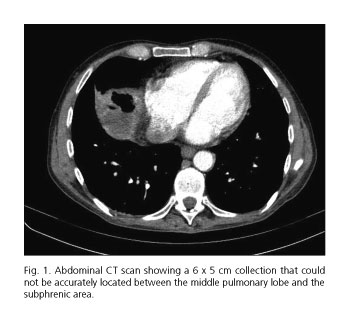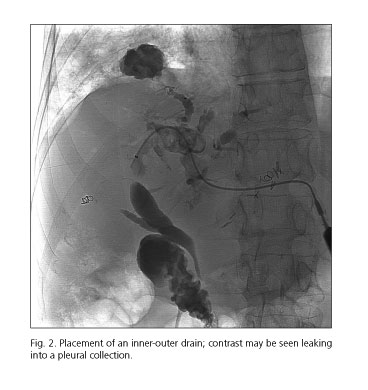Mi SciELO
Servicios Personalizados
Revista
Articulo
Indicadores
-
 Citado por SciELO
Citado por SciELO -
 Accesos
Accesos
Links relacionados
-
 Citado por Google
Citado por Google -
 Similares en
SciELO
Similares en
SciELO -
 Similares en Google
Similares en Google
Compartir
Revista Española de Enfermedades Digestivas
versión impresa ISSN 1130-0108
Rev. esp. enferm. dig. vol.109 no.4 Madrid abr. 2017
PICTURES IN DIGESTIVE PATHOLOGY
A bronchobiliary fistula treated with cyanoacrylate glue in a patient with liver cirrhosis
Fístula bilio-bronquial en un paciente con cirrosis hepática tratada mediante sellado con cianocrilato
Raúl Honrubia-López, Ana Barbado-Cano, Gloria Ruiz-Fernández and Katherine Yelenia Bustamante-Robles
Department of Digestive Diseases. Hospital Universitario La Paz. Madrid, Spain
Case report
A 60-year-old male was operated on in 2002 for liver hydatidosis, which included a partial right hepatectomy with cholecystectomy and bilioduodenal anastomosis. He then developed liver cirrhosis secondary to left hepatic duct stricture. He presented at the Emergency Room with a dry cough he had been suffering for a month, which then became associated with a yellowish, bitter-tasting "fluid" expectoration. A chest-abdominal CT scan revealed a 6 x 5 cm collection roughly located somewhere between the middle pulmonary lobe and the subphrenic area (Fig. 1). A fistula was suspected, which prompted a sputum biochemistry test that was positive for bilirubin. Given the patient's impaired liver function due to his liver disease, conservative treatment was initiated with an inner-outer drain under transparietal hepatic cholangiography (TPHC) to promote bile outflow via the duodenum (Fig. 2). Subsequently, TPHC was used to locate the point where contrast leaked from the biliary tree into a pleural cavity, and the fistula was sealed using cyanoacrylate glue, which resulted in an improvement of symptoms.
Discussion
A bronchobiliary fistula is an uncommon condition that communicates a bile duct with the bronchial tree. Etiology is variable, with infection such as hydatidosis being the most common cause. It may also result from bile duct trauma, surgery (1), and obstruction. Diagnosis is often based on imaging studies, but an exact location is at times difficult to establish. Suspicious characteristics are needed for the diagnosis, as well as the presence of bilirubin in a sputum sample (2). Treatment is surgical, but intervention care may be considered for high-risk patients with a similar effectiveness (3).
References
1. Altorio RA, McAllister JD, Sestric GB, et al. Hepatopulmonary fistula: Treatment with biliary metallic endoprosthesis. Am J Gastroenterol 1992;87(6):784-6. [ Links ]
2. Rose DM, Rose AT, Chapman WC, et al. Management of bronchobiliary fistula as a late complication of hepatic resection. Am Surg 1998;64(9):873-6. [ Links ]
3. Watkins L, Laufer I, Evans G, et al. Biliary-bronchial fistula demonstrated by endoscopic retrograde cholnagiography. Can Med Assoc J 1975;113(9):868-74. [ Links ]











 texto en
texto en 



